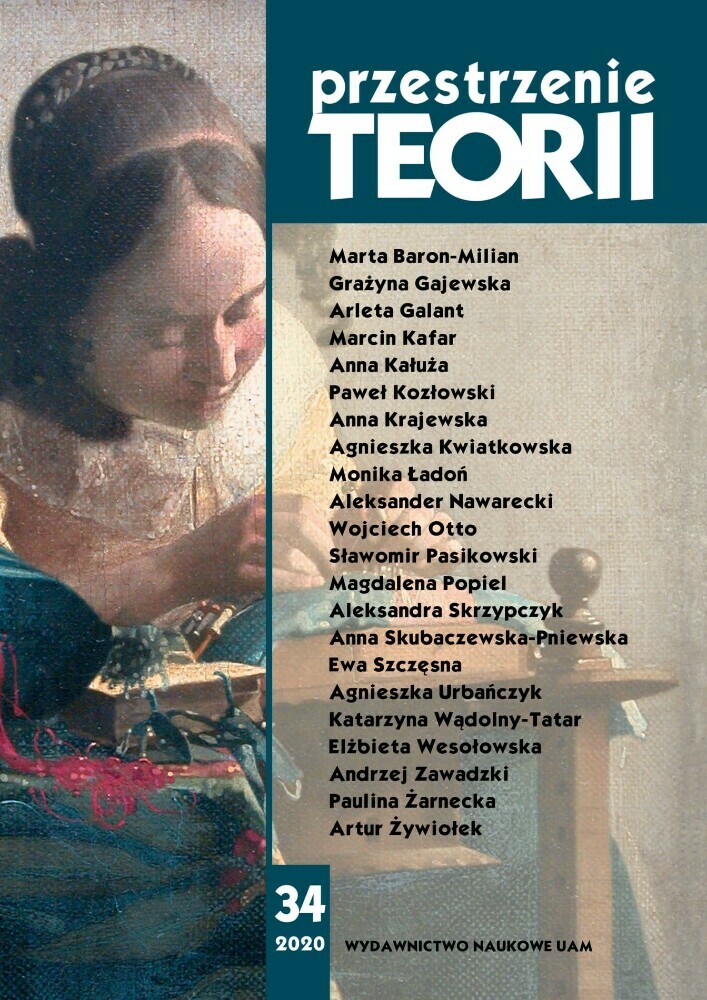Abstrakt
The article analyses the way in which disability is portrayed in contemporary Polish literature for children, with a particular emphasis on the latest literature. Rosemarie Garland-Thomson’s theory of the baroque stare is applied in the analysis and allows the reconstruction of a network of stares in which the disabled are entangled, and also to reconstruct the place attributed to them in society. In a number of texts, a confrontation with onlookers turns out to be an introduction to a dialogue that gives a disabled person a chance to express their feelings and needs. However, the increasingly common portrayal of disability in the social category does not free literature from stereotypes.
Bibliografia
Baskin B.H., Harris K., Notes from a Different Drummer: A Guide to Juvenile Fiction Portraying the Handicapped, New York 1977.
Bourdieu P., Passeron J.C., Reprodukcja. Elementy teorii systemu nauczania, Warszawa 1990.
Bourdieu P., Wacquant L., Zaproszenie do socjologii refleksyjnej, przeł. A. Sawisz, Warszawa 2001.
Czermińska M., Autobiograficzny trójkąt: świadectwo, wyznanie i wyzwanie, Kraków 2014.
Daniels K., What Teachers Never Taught And Writers Feared To Write: Disability in African American Children’s Literature, „Disability Studies Quarterly” 2004, vol. 24, no. 1, <https://dsq-sds.org/article/view/842/1017> [dostęp: 9.06.2020].
Davis L.J., The End of Normal: Identity in a Biocultural Era, Michigan 2014.
Dowker A., The Treatment of Disability in 19th and Early 20th Century Children’s Literature, „Disability Studies Quarterly” 2004, vol. 24, no. 1, <https://dsq-sds.org/article/view/843/1018> [dostęp: 9.06.2020].
Fidowicz A., Niepełnosprawność w Polskiej literaturze dla dzieci XIX wieku, „Wielogłos” 2006, 4, s. 11–126.
Foucault M., Słowa i rzeczy. Archeologia nauk humanistycznych, Gdańsk 2006.
Garland-Thomson R., Becoming Disabled, „The New York Times”, 19.08.2016, <https://www.nytimes.com/2016/08/21/opinion/sunday/becoming-disabled.html> [dostęp 10.06.2020].
Garland-Thomson R., Extraordinary Bodies: Figuring Physical Disability in American Culture and Literature, New York 2017.
Garland-Thomson R., Gapienie się, czyli o tym, jak patrzymy i jak pokazujemy siebie innym, przeł. K. Ojrzyńska, „Czas Kultury” 2019, nr 4, s. 73–81.
Garland-Thomson R., Niezwykłe ciała, przeł. N. Pamuła, „Dialog” 2019, nr 7–8, s. 752–753.
Garland-Thomson R., Staring. How we Look, New York 2009.
Garland-Thomson R., The Story of My Work: How I Became Disabled, „Disability Studies Quarterly” 2014, vol. 34, no. 2.
Gervay S., Butterflies: Youth Literature as a Powerful Tool in Understanding Disability, „Disability Studies Quarterly” 2004, vol. 24, no. 1, <https://dsq-sds.org/article/view/844/1019> [dostęp: 12.06.2020].
Keith L., What Writes Did Next: Disability, Illness and Cure in Books in the Second Half of the 20th Century, „Disability Studies Quarterly” 2004, vol. 24, no. 1, <https://dsq-sds.org/article/view/845/1020> [dostęp: 10.06.2020].
Kraskowska E., Czytelnik jako kobieta. Wokół literatury i teorii, Poznań 2007.
Makaton w rozwoju osób ze złożonymi potrzebami komunikacyjnymi, red. B.B. Kaczmarek, Kraków 2014.
Mitchell D.T., Snyder S.L., Narrative Prosthesis. Disability and the Dependencies of Discourse, Michigan 2000.
Nowak E., Lawenda w chodakach, Warszawa 2004.
Nowak E., Wszystko, tylko nie mięta, Warszawa 2002.
Ojrzyńska K., Pamuła N., Nowe studia o niepełnosprawności w humanistyce. „Przegląd Kulturoznawczy” 2019, nr 3 (41), s. 373–382.
Rzeszutko-Iwan M., Kategorie wiedzy i władzy w dyskursie publicznym, „Acta Universitatis Lodziensis” 2014, 21, s. 24.
Świerkosz M., Stwarzanie niepełnosprawnego ciała. Kilka uwag o performatywnej teorii i praktykach teatralnych, „Czas Kultury” 2019, nr 4, s. 17–26.
Thomson P., Disability in Modern Children’s Fiction, „Books for Keeps” 1992, no. 75,
<http://booksforkeeps.co.uk/printpdf/issue/75/childrens-books/articles/other-articles/disability-in-modern-childrens-fiction> [dostęp: 9.06.2020].
Unseen Childhoods Disabled Characters in 20th-century Books for Girls, red. H.A. Aveling, London 2009.
Wolanin A., Odmieniec i jego postawy wobec świata w twórczości Doroty Terakowskiej, [w:] Wyczytać świat – międzykulturowość w literaturze dla dzieci i młodzieży, red. B. Niesporek-Szamburska, M. Wójcik-Dudek, Katowice 2014, s. 175–183.
Zabawa K., Ryzyko spotkania z Innym – niepełnosprawny we współczesnej literaturze dla dzieci, [w:] Edukacja polonistyczna wobec Innego, red. A. Janus-Sitarz, Kraków 2014, s. 121–142.
Zdrodowska M., Odrzucenie protezy: performens, polityka, tożsamość, „Czas Kultury” 2019, nr 4, s. 66–71.
Licencja
Autorzy
Autorzy tekstów przyjętych do publikacji w czasopiśmie „Przestrzeniach Teorii” są zobowiązani do wypełnienia, podpisania i odesłania na adres redakcji umowy o udzielenie nieodpłatnej licencji do utworów, z zobowiązaniem do udzielania sublicencji CC.
Zgodnie z umową, autorzy tekstów opublikowanych w czasopiśmie „Przestrzeniach Teorii” udzielają Uniwersytetowi im. Adama Mickiewicza w Poznaniu niewyłącznej i nieodpłatnej licencji oraz zezwalą na użycie sublicencji Creative Commons Attribution-NonCommercial-NoDerivatives 4.0 International (CC BY-NC-ND 4.0).
Autorzy zachowują prawa do dalszego, swobodnego rozporządzania utworem.
Autorzy, którzy wykorzystują w swoim tekście cudze utwory (np. ilustracje, fotografie) proszeni są o dostarczenie do redakcji czasopisma zgodę na publikację od uprawnionych podmiotów.
Użytkownicy
Zainteresowani użytkownicy internetu uprawnieni są do korzystania z utworów opublikowanych po 2015 roku „Przestrzeniach Teorii” tylko w calach niekomercyjnych, pod następującymi warunkami:
- uznanie autorstwa - obowiązek podania wraz z rozpowszechnionym utworem, informacji, o autorstwie, tytule, źródle (odnośniki do oryginalnego utworu, DOI) oraz samej licencji;
- bez tworzenia utworów zależnych - utwór musi być zachowany w oryginalnej postaci, nie można bez zgody twórcy rozpowszechniać np. tłumaczeń, opracowań.
Do wszystkich tekstów opublikowanych przed 2015 r. prawa autorskie są zastrzeżone.
Inne
Uniwersytet im. Adama Mickiewicza w Poznaniu zachowuje prawo do czasopisma jako całości (układ, forma graficzna, tytuł, projekt okładki, logo itp.).

